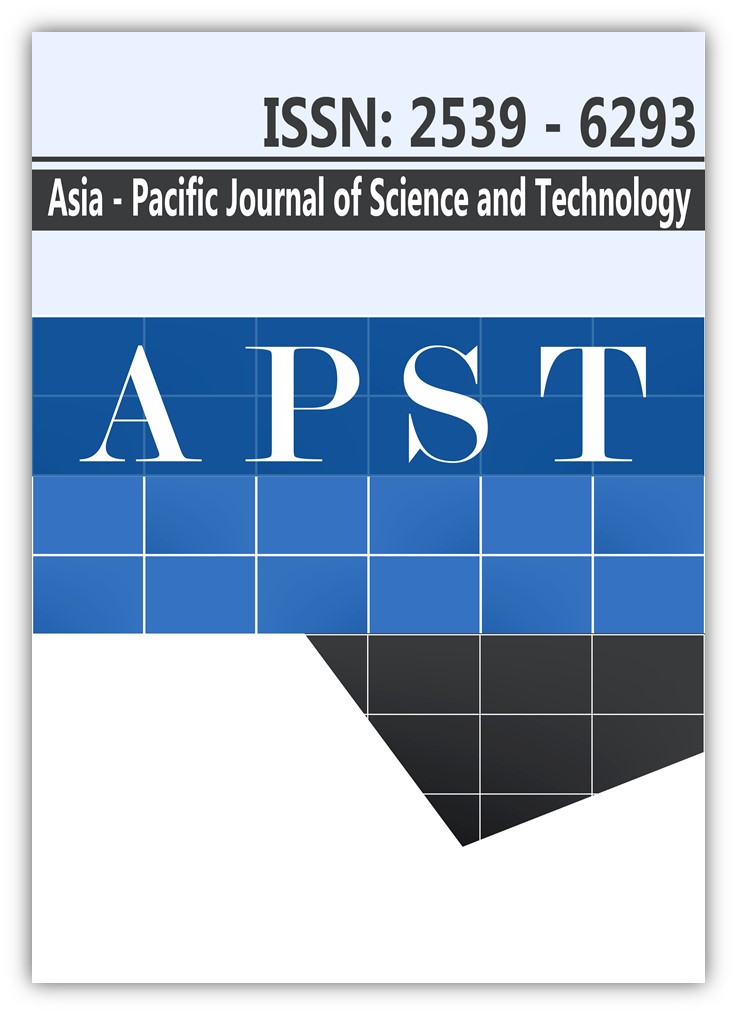Proportion of workers having work-related asthma symptoms in a cassava factory, Nakhon Ratchasima province, Thailand
Main Article Content
Abstract
Flour dust is one of work-related asthma (WRA) allergens. Few researches have been done on WRA symptoms in workers exposed to cassava starch. The aim of this study was to determine the proportion of WRA symptoms and definite WRA in a cassava factory. We conducted a descriptive study in which a sample of 148 employees was identified at a cassava factory in Nakhon Ratchasima. All had worked 6 months or longer. The study included: 1) screening for asthma-like symptoms using a modified ECRHS questionnaire; 2) screening for WRA symptoms using a questionnaire and physical examination by an occupational medicine doctor; and, 3) diagnosis confirmation using serial peak expiratory flow interpreted by OASYS-2 software. Descriptive statistics were used to assess the findings. The response rate was 87.2% (129/148) -males comprised 72.1% (93/129) of the sample. The proportion of asthma-like symptoms was 58.1% (75/129). Among 129, WRA symptoms was 11.6% (95%CI: 6.6, 17.3) and definite WRA was 3.1% (95%CI: 0.7, 6.5). In the 15 cases of WRA symptoms, 60% had a job task with high exposure to cassava starch. In cases of respiratory symptoms, most (86.7%) had upper respiratory symptoms and all had lower respiratory symptoms. Cough and dyspnea were the most common lower respiratory symptoms (each was 60%) followed by chest tightness (53.3%) and wheezing (26.7%). WRA symptoms and definite WRA constituted 11.6% and 3.1% in a cassava starch factory, respectively. The results showed a consistence with previous studies in developing nations. Cassava starch, like wheat flour, may cause WRA.
Article Details
References
Blanc PD, Toren K. How much adult asthma can be attributed to occupational factors? Am J Med. 1999;107(6):580-587.
Jeebhay MF. Work-related asthma. Contin Med Educ 2009;27(11):496-501.
Torén K, Blanc PD. Asthma caused by occupational exposures is common-a systematic analysis of estimates of the population-attributable fraction. BMC Pulm Med [Internet] 2009 [cited 2019 Sep 15]. Available from: https://bit.ly/2Rb7Hp9
Vandenplas O. Occupational asthma: etiologies and risk factors. Allergy Asthma Immunol Res. 2011;3(3):157-167.
Smith TA, Lumley KP. Work-related asthma in a population exposed to grain, flour and other ingredient dusts. Occup Med Oxf Engl. 1996;46(1):37-40.
Talini D, Benvenuti A, Carrara M, Vaghetti E, Martin LB, Paggiaro PL. Diagnosis of flour-induced occupational asthma in a cross-sectional study. Respir Med. 2002;96(4):236-243.
Ijadunola KT, Erhabor GE, Onayade AA, Ijadunola MY, Fatusi AO, Asuzu MC. Prevalence of respiratory symptoms among wheat flour mill workers in Ibadan, Nigeria. Am J Ind Med. 2004;45(3):251-259.
Ajeel NA, Al-Yassen AK. Work-related allergic disorders among flour mill workers. Med J Basrah Univ. 2007;25(1):29-32.
Zhu F. Composition, structure, physicochemical properties, and modifications of cassava starch. Carbohydr Polym. 2015;122:456-480.
Molenda M, Stasiak M, Horabik J, Fornal J, Blaszczak W, Ornowski A. Microstructure and mechanical parameters of five types of starch. Pol J Food Nutr Sci. 2006;56(2):161-168.
Koh SP, Long K. Comparison of physical, chemical and functional properties of broken rice and breadfruit starches against cassava starch. J Trop Agric Food Sci. 2012;40(2):211-219.
Wiggans R, Pilling J, Hoyle J. Tapioca starch powder as a new cause of occupational asthma in bakers. Eur Respir J. 2018;52(Suppl 62):PA4529.
Chaiear N, Jongkumchok W, Boonsawat W, Chaisuksant S. Work-related asthma amongst asthmatic patients in the easy asthma clinics in Khon Kaen, Thailand. Occup Environ Med. 2018;75(Suppl 2):A460-461.
Cullinan P, Taylor AN. Occupational asthma. In: Baxter P, Hunter D, editors. Hunter’s diseases of occupations. 10th ed. London: Hodder Arnold; 2010. p. 941-957.
Balmes JR. Occupational lung diseases. In: LaDou J, editor. Current occupational and environmental medicine. 5th ed. New York: McGraw-Hill Medical; 2014. p. 362-385.
Grassi M, Rezzani C, Biino G, Marinoni A. Asthma-like symptoms assessment through ECRHS screening questionnaire scoring. J Clin Epidemiol. 2003;56(3):238-247.
Chaiear N, Sadhra S, Jones M, Cullinan P, Foulds IS, Burge PS. Sensitisation to natural rubber latex: an epidemiological study of workers exposed during tapping and glove manufacture in Thailand. Occup Environ Med. 2001;58(6):386-391.
Jares EJ, Baena-Cagnani CE, Gómez RM. Diagnosis of occupational asthma: an update. Curr Allergy Asthma Rep. 2012;12(3):221-231.
Burge PS, Moore VC, Burge CBSG, Vellore AD, Robertson AS, Robertson W. Can serial PEF measurements separate occupational asthma from allergic alveolitis? Occup Med Oxf Engl. 2015;65(3):251-255.
National Asthma Education and Prevention Program. How to use a peak flow meter [Internet]. 2013 [cited 2019 Oct 5]. Available from: https://bit.ly/34Ji8ob
Gannon PF, Newton DT, Belcher J, Pantin CF, Burge PS. Development of OASYS-2: a system for the analysis of serial measurement of peak expiratory flow in workers with suspected occupational asthma. Thorax. 1996;51(5):484-489.
Dejsomritrutai W, Nana A, Chierakul N, Tscheikuna J, Sompradeekul S, Ruttanaumpawan P, et al. Prevalence of bronchial hyperresponsiveness and asthma in the adult population in Thailand. Chest. 2006;129(3):602-609.
El Gewily MS, El Husseini M, Beshir S, Elserougy S, Hafez SF, El Hamshary MS. Diagnosis of occupational asthma in flour mills at South Cairo. Egypt J Community Med. 2018;36(1):95-103.
Malo J-L, Chan-Yeung M. Agents causing occupational asthma. J Allergy Clin Immunol. 2009;123(3):545-550.
Meo SA. Dose responses of years of exposure on lung functions in flour mill workers. J Occup Health. 2004;46(3):187-191.
Prichard MG, Ryan G, Musk AW. Wheat flour sensitisation and airways disease in urban bakers. Occup Environ Med. 1984;41(4):450-454.
Walters GI, Soundy A, Robertson AS, Burge PS, Ayres JG. Understanding health beliefs and behavior in workers with suspected occupational asthma. Respir Med. 2015;109(3):379-388.
Poonai N, van Diepen S, Bharatha A, Manduch M, Deklaj T, Tarlo SM. Barriers to diagnosis of occupational asthma in Ontario. Can J Public Health. 2005;96(3):230-233.
Bradshaw LM, Barber CM, Davies J, Curran AD, Fishwick D. Work-related asthma symptoms and attitudes to the workplace. Occup Med Oxf Engl. 2007;57(1):30-35.
Oh SS, Kim KS. Occupational asthma in Korea. J Korean Med Sci. 2010;25(Suppl):S20-25.


